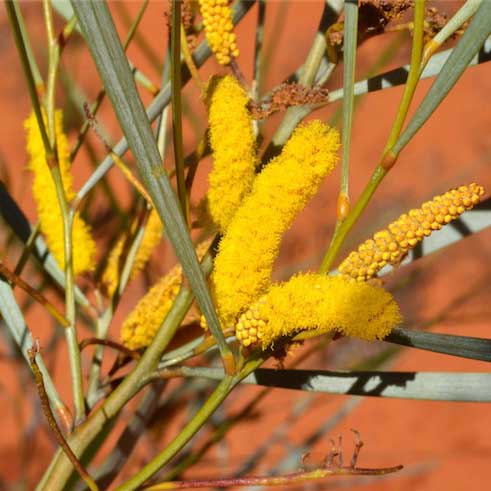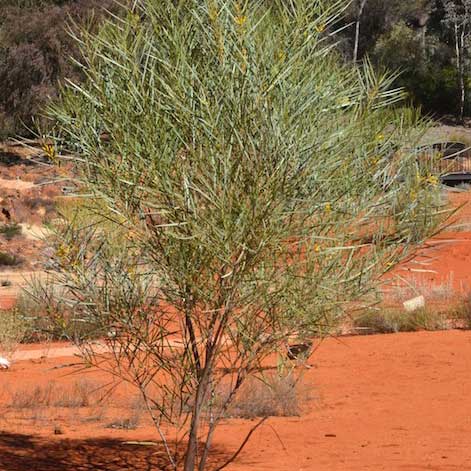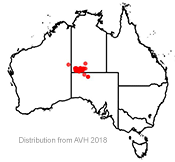Acacia ammobia
 |
 |
Mount Conner Wattle
 Acacia ammobia, commonly known as Mount Conner Wattle, is a shrub or small tree that grows from 1.5 to 7 m tall. Acacia ammobia is a member of the family Fabaceae and to the iconic Australian wattle genus (Acacia). This rare species occurs in the arid-zone of the Northern Territory and South Australia, where it can be seen growing on sandy or gravelly soils, including on the crests of dunes.
Acacia ammobia, commonly known as Mount Conner Wattle, is a shrub or small tree that grows from 1.5 to 7 m tall. Acacia ammobia is a member of the family Fabaceae and to the iconic Australian wattle genus (Acacia). This rare species occurs in the arid-zone of the Northern Territory and South Australia, where it can be seen growing on sandy or gravelly soils, including on the crests of dunes.
The long (11 to 27 cm), straight, leaf-like phyllodes of Acacia ammobia taper at the base and apex giving the plant an elegant appearance. This, paired with their distinctive yellow, densely flowered spikes which grow to become 2 - 5 cm long, provide Acacia ammobia with a highly attractive form.
Growing this plant from seed is likely the most successful method of propagation. As with other Acacia species, the seeds are tough and will require scarification to release them from dormancy. This scarification may be achieved by abrading the seed coat with sandpaper or by nicking the seed coat with a blade.A very well-draining sandy or gravelly soil is recommended to emulate Acacia ammobia's natural environment. Planting would be best undertaken during autumn or early spring. This plant would be best placed in full sun, although it is capable of tolerating partial shade. Deep watering should be provided to a young plant. However, watering should be reduced as the plant establishes and soil should be allowed to fully dry before re-watering, to prevent root rot.
Acacia ammobia is a hardy plant that requires little care. It has been shown to tolerate the frosts and the variable weather of Canberra where it is growing well in the Australian National Botanic Gardens. However, young plants (<1 m tall) are likely to benefit from frost protection. This plant also seems to be quite disease- and pest-resistant. No pruning is needed. Acacia ammobia self-prunes as the lower branches die back, giving it the appearance typical of the species. Although Acacia ammobia is capable of surviving in poor soil, if it is deemed to need fertilising, a low phosphorus native fertiliser would be best applied.
Luke Richmond, Volunteer Botanical Training Program Participant 2018
Name meaning: Acacia ammobiaAcacia - either from a Greek word meaning to sharpen, or referring to the Egyptian Thorn (akakia) ammobia - 'sand dweller', alluding to the habitat of the species |
References:
Department for Environment and Water Government of South Australia (n.d). Rare plants of the APY Lands - Acacia ammobia Mt. Connor Wattle. Available at https://www.environment.sa.gov.au/files/sharedassets/public/plants_and_animals/accacia_ammobia.pdf [Accessed 11 Feb. 2018].
McMahon, M. (2018). Horticulturist, Australian National Botanic Gardens. Personal communication.
South Australian Seed Conservation Centre (2018). Acacia ammobia (Leguminosae) Mount Conner Wattle. Available at http://saseedbank.com.au/species_information.php?rid=100 [Accessed 11 Feb. 2018].
Tindale, M.D., Kodela, P.G. et al. (2001) Acacia ammobia in Flora of Australia, Volume 11B, Mimosaceae, Acacia part 2. Melbourne: ABRS/CSIRO Publishing. Available at http://www.anbg.gov.au/abrs/online-resources/flora/stddisplay.xsql?pnid=41796 [Accessed 13 Feb. 2018].
Wilson, G., Pickering, M., & Kay, G. (2005). Angas Downs Indigenous Protected Area Plan of Management. Australian Wildlife Services: Canberra.
![An Australian Government Initiative [logo]](/images/austgovt_brown_90px.gif)

